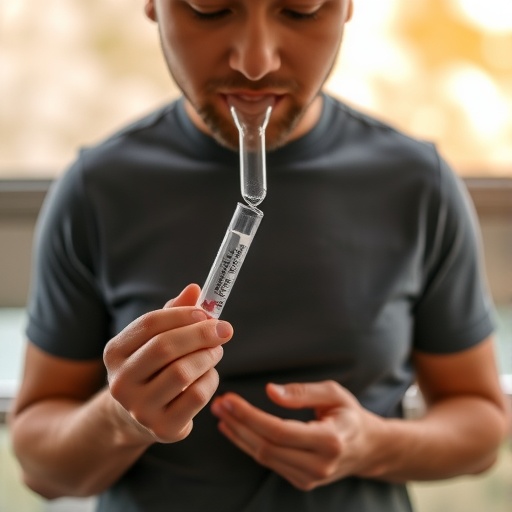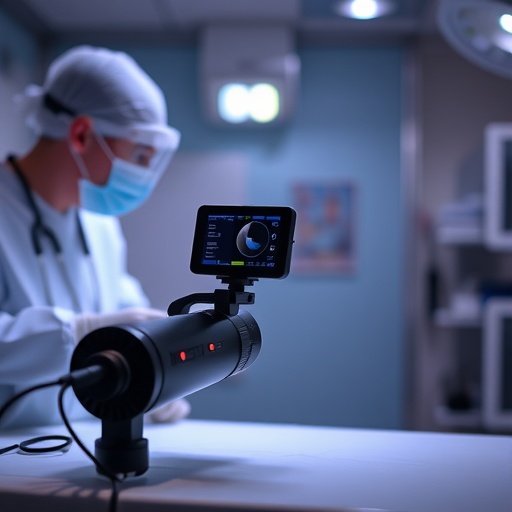A groundbreaking study led by researchers at UBC Okanagan is challenging conventional methods of metabolic health assessment by demonstrating that insulin levels measured through saliva can serve as a reliable, non-invasive biomarker for predicting the risk of Type 2 diabetes and obesity. This innovative approach diverges from the traditional reliance on blood glucose testing by harnessing the physiological links between saliva insulin and metabolic dysfunction, offering a promising tool for early detection and intervention.
Type 2 diabetes, a global health crisis affecting approximately 400 million people, has traditionally been diagnosed based on elevated blood glucose levels. However, the period leading up to the manifestation of overt diabetes—known as prediabetes—is characterized by subtle yet critical metabolic changes, including insulin resistance and hyperinsulinemia, which can precede definitive diagnosis by 10 to 20 years. Recognizing the necessity for earlier detection, the UBC research team focused on measuring hyperinsulinemia, a condition marked by elevated insulin concentrations that signals an increased risk of developing diabetes, cardiovascular disease, and obesity.
Dr. Jonathan Little, a professor at UBC Okanagan’s School of Health and Exercise Sciences and lead investigator of the study, explains that while current metabolic screening involves blood draws and invasive procedures, saliva insulin measurement offers a painless, accessible alternative. The team conducted a randomized controlled clinical trial encompassing 94 participants with varying body compositions, who after fasting consumed a standardized meal-replacement shake. Subsequent saliva samples and finger-prick blood tests were collected at intervals to compare saliva insulin concentrations with blood glucose levels.
.adsslot_aebLlWpJQI{width:728px !important;height:90px !important;}
@media(max-width:1199px){ .adsslot_aebLlWpJQI{width:468px !important;height:60px !important;}
}
@media(max-width:767px){ .adsslot_aebLlWpJQI{width:320px !important;height:50px !important;}
}
ADVERTISEMENT
The results were striking: individuals with obesity exhibited significantly higher saliva insulin levels compared to their overweight or normal-weight counterparts, despite showing similar blood glucose readings. This finding suggests that saliva insulin concentrations can act as a sentinel biomarker, revealing heightened metabolic risk before traditional glucose markers indicate diabetes onset. Such insight carries profound implications for public health, as early identification can facilitate timely lifestyle modifications and therapeutic interventions aimed at halting or reversing disease progression.
Further intriguing was the observation that some lean participants demonstrated pronounced spikes in saliva insulin following the meal challenge, despite having normal blood glucose levels. This unexpected finding challenges the prevailing paradigm that excess weight is the primary driver of metabolic risk, revealing that lean individuals may harbor metabolic vulnerabilities undetectable by conventional measures. Hence, saliva insulin testing could redefine risk stratification by transcending simplistic metrics like BMI and waist circumference.
Co-author Dr. Hossein Rafiei highlights the dynamic nature of saliva insulin responses, emphasizing that their prior research had shown a strong correlation between plasma and saliva insulin throughout the day, even when comparing high- and low-carbohydrate meals. This study extends those findings by revealing temporal insulin fluctuations within saliva after a standardized mixed meal, capturing metabolic nuances that could be invaluable for clinical assessment.
Notably, the research also underscores waist circumference as the anthropometric measure most closely associated with saliva insulin levels. This aligns with growing evidence that central adiposity drives metabolic dysfunction, rather than total body weight alone. By integrating saliva insulin testing with waist measurements, clinicians may gain a sophisticated yet practical approach to metabolic risk screening.
Mechanistically, elevated insulin levels in saliva likely reflect pancreatic beta-cell hyperactivity and peripheral insulin resistance. Early hyperinsulinemia ramps up insulin secretion to compensate for decreased tissue sensitivity, a compensatory state that, if persistent, contributes to systemic metabolic derangements. Saliva sampling captures this phenomenon in a user-friendly manner, opening new vistas for research into pathophysiological mechanisms and personalized medicine.
Importantly, the adoption of saliva insulin testing could democratize access to metabolic health evaluation, especially in resource-limited settings or among populations with aversion to needles and blood draws. This could facilitate broader screening efforts and reduce disparities in diabetes prevention and management.
While the technology and techniques for accurately quantifying saliva insulin require further refinement and validation in larger diverse cohorts, this study lays compelling groundwork for the future. Continued research could also explore integrating this biomarker with other salivary analytes to develop multiplexed non-invasive assays, propelling metabolic diagnostics into a new era.
In summary, this innovative study from UBC Okanagan propels saliva insulin testing to the forefront of metabolic research, offering a simple yet powerful method to detect early metabolic disruptions before the onset of Type 2 diabetes and obesity. By capturing physiological alterations that traditional blood glucose tests may miss, this approach holds the potential to revolutionize preventive healthcare strategies and improve outcomes for millions worldwide.
Subject of Research: People
Article Title: Saliva insulin concentration following ingestion of a standardized mixed meal tolerance test: influence of obesity status
News Publication Date: 16-May-2025
Web References: http://dx.doi.org/10.1139/apnm-2024-0532
References: Applied Physiology Nutrition and Metabolism, DOI: 10.1139/apnm-2024-0532
Image Credits: UBC Okanagan
Keywords: Health care, Diseases and disorders, Human health, Epidemiology
Tags: early detection of obesityhyperinsulinemia detection methodsinnovative diabetes screening techniquesinsulin levels and metabolic healthmetabolic dysfunction indicatorsnon-invasive diabetes biomarkersprediabetes risk assessmentsaliva insulin and cardiovascular diseasesaliva testing for diabetessaliva-based health assessmenttype 2 diabetes prevention strategiesUBC Okanagan diabetes research





